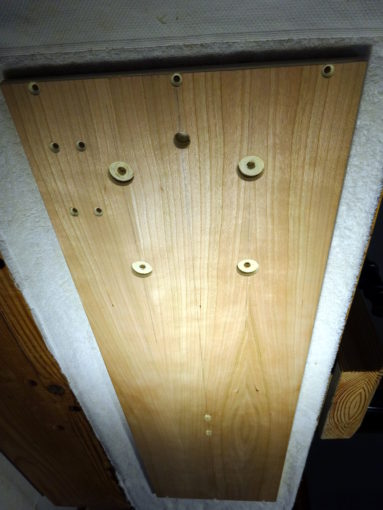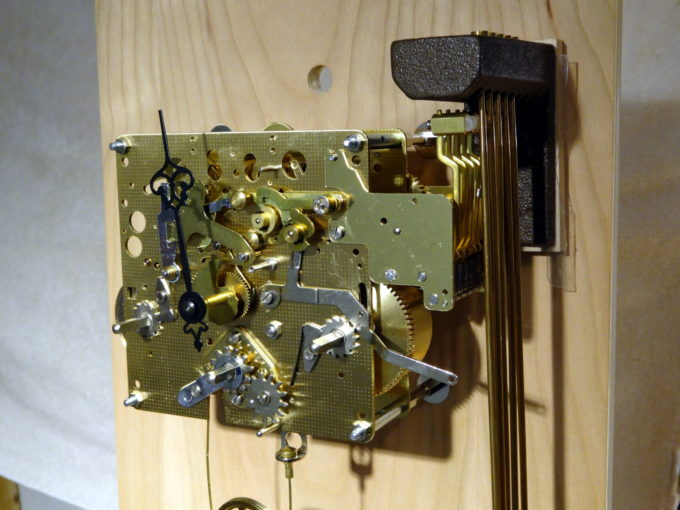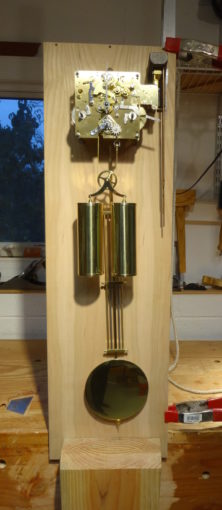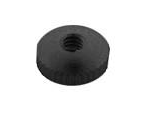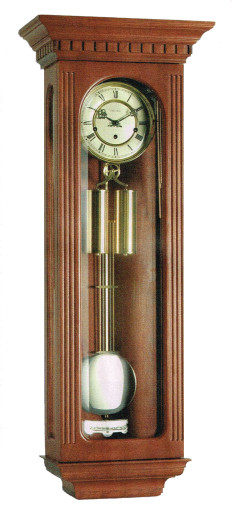Gratitude – clock oil
Some mechanical clocks are regulated by pendulums. Those clocks can’t be wandering around. The pendulum must swing an equal distance to each side of a center line that runs through the escapement. That center line needs to be plumb and fixed so it doesn’t move. This requirement makes the back board the most critical piece of the clock case. Not only does the back board hold the movement and chime rods in place, it also needs to provide a way for hanging the case on the wall and keeping it fixed in place. Here, we see the back side of the backboard. A through hole on the center line near the top of the board is the single hang point for the case. About two-thirds the way down the line is a slot which fits snugly over a screw head protruding from the wall, keeping the case from wandering.
Keen observers will note two such slots. The first slot is the result of one of my pet peeves: measuring instruments have far too many marks on them, leading to errors. The second slot is the one I’ll actually use.
The board is cherry faced plywood (ouch it hurts to use that word / stuff). It is wide enough to be concerned about movement, so I relented to using plywood. It is drilled with 3 holes along the top edge and 3 along the bottom for fastening the board to the rest of the case. The four larger inset holes are for mounting the clock movement. Insetting whose holes keeps steel nuts from scraping on a wall. The four smaller countersunk holes are for mounting the chime block.
Only a couple of companies still manufacture mechanical clock movements. This one is by Hermle. It has three trains. Left to right (see the square winding pegs) they are: the hours chimes, the time, and the 1/4 hour chimes. Both chime trains are spring driven. Note the spring holding cylinders behind the winding pegs. The time train is weight driven, providing a steady source of power that does not vary as a spring might. Thus, a well regulated clock.
BTW, the spring for the 1/4 hour chimes has the yeoman’s job and is much heavier than the spring for the hours train. That heavy spring could probably be an alternate power source for when Tesla decides to quit making coal-powered automobiles.
In these pictures, the back board is positioned in my bench vise so that it is level across the top, making the center line plumb. The movement is also mounted so that it too is level across the top. …and yes, the clock was running, making the pendulum look off plumb, because it was swinging.
The chimes are copper rods set into an iron block that is positioned so the chime rods are about 1/8 inch from the tips of the hammers when the hammers are “at rest.” A spacer block completes the positioning of the chimes rods.
I set it up this way to test the works, while they are not obscured by the case. This movement has been sitting unused in storage for at least three years. Upon setting it up, the 1/4 hour strike train ran very very slow, taking about 2 seconds to strike a single note. I put the pendulum in its hanger, set the escapement for an even beat and let it run overnight, hoping that some run-in would free up the slow parts. Didn’t happen. Having some clock oil on hand from previous clock work, I sparingly oiled every pivot. That worked. The chimes are now running at full speed and the time train is also running smoothly.
The escapement consists of the pendulum and a pallet bar that controls the turning of the escape wheel. The pallet bar can be adjusted on its shaft to produce the correct action, and that action is noted by a very even beat between the ticks of the pallets striking the escape wheel. This video show the setting is pretty close, maybe not perfect, but close enough for initial testing.
Next, we have the nicely running chimes.
Before long, I’ll take all the pretty stuff off the back board and put it safely aside so I can continue building the rest of the case.
Other articles in this series…
- Regulator Clock – Done
- Regulator Clock – Woodworking completed
- Regulator Clock – Scratching the frames
- Regulator Clock – Door Hinged
- Regulator Clock – Case Dry Fitted
- Regulator Clock – Jelly Side Down
- Regulator Clock – Case Frames – 2
- Regulator Clock – Glass – 2
- Regulator Clock – Case Frames – 1
- Regulator Clock – The Works work
- Regulator Clock – Glass
- Regulator Clock – Tongue & Groove planes
- Regulator Clock – Completed Mouldings
- Regulator Clock – Stick Mouldings
- Regulator Clock – Plate Mouldings
- Regulator Clock – Egg and Dart Moulding
- Regulator Clock – Eat Dessert First
- Regulator Clock – original description
- Regulator Clock – Stock Prep
- Regulator Clock – Plans for Moldings
- Taming the Rabbet
